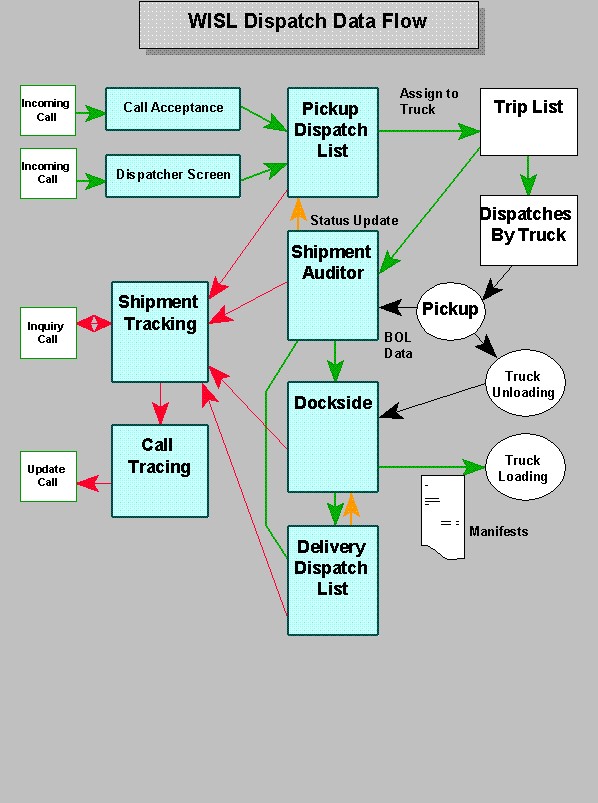
WISL Dispatch System
Overview
Waterloo Information Systems Limited
33 Dupont Street East
Waterloo, Ontario
N2J 2G8
© Waterloo Information Systems Limited 1996
The information contained herein is proprietary and considered a trade secret of Waterloo Information Systems Limited and shall not be reproduced in whole or in part without the written authorization of Waterloo Information Systems Limited.
Introduction
The WISL Dispatch System is a collection of modules which handles both the record-keeping aspects of the dispatch process and the interface between dispatch and terminal functions. The Dispatch system consists of four major components: the pick-up dispatching system, the shipment auditor routine, the dockside functions, and the delivery dispatch system.
Information collected from pick-up dispatch calls permits on-line shipment tracking and reporting. In addition to the dispatcher's and supervisor's screens, a facility allows the acceptance of dispatch phone calls by a non-dispatcher and makes this information available to the dispatcher.
The audit routine for the verification of bills of lading provides the on-line look up of cubing or weighing status for individual shippers, allows for collection of data required for billing and provides summary information by driver for later use by financial systems. All dispatch data is available for summary, analysis and reporting.
The dockside functions serve as a checkpoint for the incoming and outgoing shipments and provides control over the loading process. Each shipment is checked off as it is received or shipped. Rush or aged shipments are listed for special attention, and a list of outstanding shipments is available for a comparison against dockside inventory.
The delivery dispatch system interfaces with a master manifest generated in the dockside procedure. The individual shipments are verified and aggregated into loads for final delivery. All shipment data is provided on-line for point-to-point tracking.
All four components have access to an inquiry routine for tracking shipments entered into the system; in addition, a follow-up function allows the recording of inquiry information for upcoming shipments. As shipments are received, the system matches them against follow-up data and notifies an operator to contact the appropriate shipper/consignee.
The shipment or pro-bill ID may be automatically assigned by the system or input from a label affixed to the shipment. If barcode labels are utilized, WISL Dispatch provides streamlined interactive routines in the shipment auditor and dockside functions to accommodate laser scanning including RF scanning networks.
WISL Dispatch interfaces directly with rating/billing or routing functions as required. Also included is the capability to maintain and inquire on the location and load status of trailers. WISL Dispatch provides a reliable and integrated control mechanism for handling and routing shipments.
Pick-up Dispatch Function
Dispatcher routine
- accepts called-in information about incoming goods
- maintains the current status of each dispatch
- inquiry on individual dispatches
- options to sort dispatch calls in various orders to provide operational overview
- assigns shipments to drivers and trucks based on
region/route
- entry of biographic information on shippers
Call Acceptance Function
- accepts called-in information and transfers it to
dispatcher
- inquiry on individual dispatches
- available from any on-line terminal
Shipment Auditor Routine
- matches incoming bills of lading against the dispatch
information
- accesses customer information to determine weighing or
cubing requirements
- records bill of lading data, and allows alteration for
amounts changed by weighing and cubing processes
- automatic generation of records to be passed to rating/billing facilities
- verification of new consignee and shipper information
- generation of handle copy with bar coding
Dockside Function
- priority and backlogged shipment information
- online checklist for loaded shipments
- dockside report for inventory of shipments
- barcode scanning data entry with handle copy or bill of lading
Delivery Dispatch Routine
- shipment tracking and inquiry
- truck consolidation by delivery route or region
- access to consignee information
In addition to the four main operational functions, the system also offers the following:
Shipment Tracking & Tracing
- dispatch or shipment records may be accessed by key data attributes and displayed to determine status.
- a trace record can be initiated for follow-up if a dispatch or shipment record cannot be initially located.
EDI
- change in status of a shipment record at any point in the system can automatically generate an EDI 214 transaction.
Reporting
- dispatch activity and summary reports
- rush shipment reports
- outstanding shipments at dockside
- outstanding follow-up requests
- summary and audit reports for
- individual BOL
- drivers
- shippers
- regions
- etc.
Supplementary File Maintenance
- regular pick-up control
- maintenance for system files
- trucks
- regions
- cities
- terminals
- drivers
- etc.
- maintenance for customer and shipper/consignee files
- supervisory routines
- clerk access control
- archiving of data files
The implementation of the WISL Dispatch System incorporates the conversion or integration of any existing data files, such as customers, consignees, etc. into WISL Dispatch file formats.
Dispatch Flow Diagram
The appended diagram illustrates the standard path followed by dispatches and shipments. Appropriate documents and reports are generated where required.
